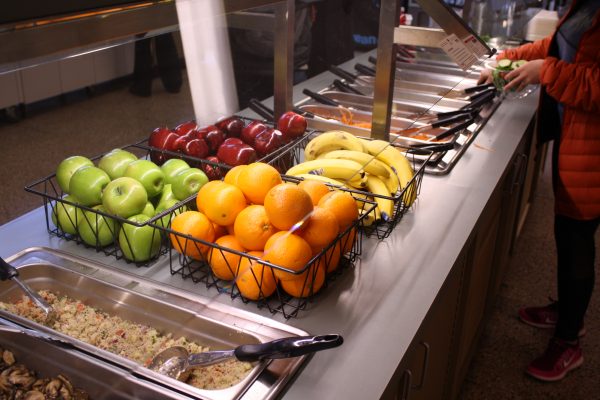Fordham Needs to Add More Vegan Options
February 8, 2017
What is there to eat when one eliminates meat, dairy, eggs and anything else produced from the exploitation of animals? The answer: not much. Combine that with being a college student living in a dorm on a budget in one of the most expensive cities in the world and it’s even less. The big question is, why are students with dietary restrictions forced into paying thousands of dollars for a meal plan that very minimally accommodates such restrictions?
Leah Johnson, Fordham College at Lincoln Center (FCLC), ’20, has been following a vegan diet for two years now. Her decision to go vegan was a reflection of ethical dilemmas and health concerns. Although Johnson is fully aware of the challenges faced by small schools to meet the needs of every student, she still argues that “It is quite simple to provide at least one healthy vegan option per meal.” Johnson added that she sometimes “[leaves] the dining hall having eaten only a salad or a bowl of oatmeal, [forcing her] to spend money on food off campus and buy groceries very frequently.”
While Johnson admits that the dining hall does sometimes offer healthy, vegan options, they are consumed by everyone and are therefore gone before many can take advantage of the occasion. Johnson sees it as a waste to swipe into the dining hall only to leave it having eaten a bowl of cereal or a plate of fruit. She speculated, “If we could count on the dining hall to provide a variety of fruits, vegetables, grains and proteins, food would be one less thing to stress about.” For the price that we are paying here at Fordham, it is not unreasonable to ask that there be more options for students with dietary restrictions, whether it’s by choice or not.
Kylie Rothwell, FCLC ‘20, has been vegan for one year now and shares Johnson’s sentiments. She is frustrated because she is compelled to spend her earned money from past jobs on groceries “when [she is] already forced to pay for the meal plan.” Rothwell further states that rarely does the dining hall cause her to feel as fulfilled as the meals she prepares in her room. The whole idea of a meal plan is to lessen the burden of buying groceries, but when such a service does not cater to every student’s needs, it in turn becomes more of a burden for the students and families paying for it.
These concerns are shared among other students as well. Chloe Griffith, FCLC ’20, offered her take, noting that “it would be beneficial and inexpensive for the dining hall to constantly have basic staples [foods] and then vegans could add on to that with whatever they wish and it would be a lot simpler.” Such staple foods, according to Rothwell and Griffith, include rice, beans and potatoes. She adds, “These [staple foods] can be left out like the soups are. Not everything has to be ‘made to order.” Rothwell expands that she “[does not] think vegans are asking for anything gourmet, [they] just want some easy options.” This is a big issue with an easy answer.
In addition to their suggestions, another solution could be to ensure that there is a constant supply of meal add-ons such as almond milk, soy milk and tofu, in addition to fruits and vegetables. Many of Fordham’s meals that contain meat could be amended by separating it from the bulk of the meal thus opening it up as an option for more students to eat while meals cooked with butter could instead be cooked with olive oil, which is a healthier dietary option.
Jane Mackowiak, Fordham College at Rose Hill (FCRH), ’19 opened up about her own campus’ dining services and how it has improved drastically with the recent introduction of Aramark as a replacement for Fordham’s previous food provider. Mackowiak expounds, “Now, with Aramark, vegetarian, vegan, gluten-free and lactose [free] options are much more attainable.” While Aramark caters to both campuses, Mackowiak points out some keen differences, mentioning certain meals that are not available or at least low in quantity at Lincoln Center such as “sushi, vegan buffalo wraps, falafel [and] an entire station designed for students with dietary restrictions.” If these options were made available at Lincoln Center, vegan students would have more options to choose from and far more diversity in their diet. Mackowiak does, however, discuss whether or not “these options [have] always been available.”
She nonetheless maintains that “Aramark is very receptive to student’s opinions and constantly [updates] their menus to cater to what the students want.” While Mackowiak does offer some encouragement for students who are dissatisfied with the dining hall, she nevertheless said, “There need to be more options, especially for vegans, but because that’s such a slim and expensive dietary restriction, it’s not their top priority.”
It is important to acknowledge the challenges that schools face to accommodate their student body as well as the fact that because vegans represent such a small population at Fordham, their needs do not trump the needs of the rest of the school. With that, the vegan students at Fordham should propose a few feasible changes to Aramark and work with them to improve the Fordham environment for everyone. The fact of the matter is that the Fordham Dining Services could very easily add more options for students with dietary restrictions if they are just willing to make a few minor adjustments to the menus. In doing this, Fordham would ensure that its students are able to enjoy and take advantage of the dining hall and get the nutrients they need.












